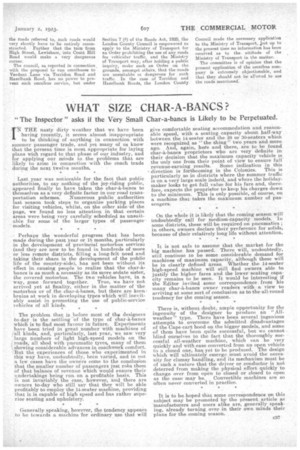WHAT SIZE CHAR-A-BANCS ?
Page 23

If you've noticed an error in this article please click here to report it so we can fix it.
"The Inspector" asks if the Very Small .
P. THE nasty dirty weather that we have been having recently, it seems almost inappropriate to be thinking of anything in connection with summer passenger trade, and yet many of us know that the present time is most appropriate for laying plans with regard to that phase of our industry, and for applying our minds to the problems that are likely to arise in connection with the coach trade during the next twelve months.
Last year was noticeable for the fact that public authorities, to say nothing of the joy-riding public appeared finally to have taken the char-habancs to themselves as a very definite factor in our road trans portation schemes. Numerous public authorities last season took steps to organize parking places for visiting vehicles, whilst, on the other side-of the page, we found no less attention in that certain areas were being very carefully. scheduled as unsuitable for some of the larger types of passenger • Perhaps the wonderful progress that has been made during the past year or is months., particularly in the development of provincial motorbus services (and they are now to be found in hundreds of more or less remote districts, filling a long-felt need and taking their share in the development of the public life of the country-side), has not been without its effect in. causing people to realize that the char-he banes is as much a, necessity as its more sedate sister,. the covered motorbus. The two vehicles have, in a way, gone forward together. True, we have not arrived yet at finality, either in the matter of 'the motorbus or of the char-k-bancs, but there are keenbrains at work in developing types which will inevitably a,ssist in promoting the use of public-service vehicles of all kinds.
The problem that ip before most of the. designers to-day is the aettling-of the type of char-k-bancs which is to find most favour in future. Experiments have been tried in great number with machines of all kinds, and, particularly, last year, we saw very large numbers of light high-speed models on the roads, all shod with pneumatic tyres, many of them showing considerable advances in coachwork comfort. But the experiences of those who experimented in this way have, undoubtedly, been varied, and in not a few cases have the owners come to the conclusion that the smaller number of passengers just robs them of that balance of revenue which would ensure their undertakings being run, on a profitable basis. This is not invariably the case,however, and there are owners to-day who still say that they will be able profitably to employ the 14-seater machine, providing that it is capable of high speed and has rather superior seating and upholstery.
Generally speaking, however, the tendency appears to be towards a, machine for ordinary use that will
Char-a-bancs is Likely to be Perpetuated.
give comfortable seating accommodation and reasonable speed, with a seating capacity about half-way between the 14-seater and the 28 or 30-seaters which were recognized as "the thing" two years and more ago. And, again, hate and there, are to be found char-h-bancs proprietors who are very definite in their decision that the maximum capacity vehicle is the only one from their point of view to ensure full revenue-earning results. Some indication in this direction is forthcoming in the Colonies. This is particularly so in districts where the summer traffic is on a very large scale indeed, and where the holidaymaker looks to get full value for his fare and, therefore, expects the proprietor to keep his charges down to the minimum. This is only possible, of course, on a machine that takes the maximum number of passengers.
On the whole it is likely that the coming season will undoubtedly call for medium-capacity models. In some districts, these will be required on pneumatics ; in others, owners declare their preference for solids, because of their relatively long life without attention.
It is not safe to assume that the market for the big machine has passed. There will, undoubtedly, still continue to be some considerable demand for machines of maximum capacity, although these will be in clearly defined areas. Whether, the 14-seater high-speed machine will still find owners able to justify the higher fares and the lower seating capacity remains to be seen. It would be interesting if the Editor invited some correspondence from his many char-k-bancs owner readers with a view to arriving at. some sort of conclusion as to the all-round tendency for the coming season.
There is, without doubt, ample opportunity for the ingenuity of the designer to produce an " Allweather ' type. There have been several ingenious attempts to overcome the admitted disadvantages of the Cape-cart hood on the bigger models, and some of them have been quite successful, but we cannot blind ourselves to the fact that the thoroughly successful all-weather machine, which can be very quickly and with ease converted from an open vehicle to a closed one, has yet to be produced. The design which will ultimately emerge ,must avoid the necessity for clumsy handling, and its mechanism must be of such a nature that the driver or conductor is not deterred from making the physical effort quickly to change over from open to closed or closed to open as the case may be. Convertible machines are so often never converted in practice.
It is to be hoped that some correspondence on this subject may be promoted by the present article as Manufacturers and users alike are, generally speaking, already turning over in their own minds their plans for the coming season.






























